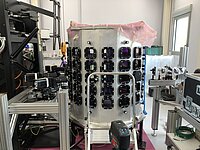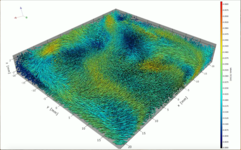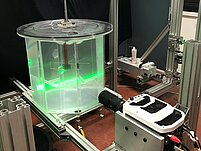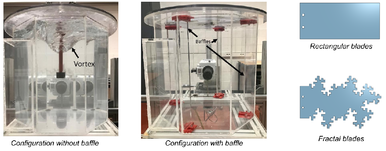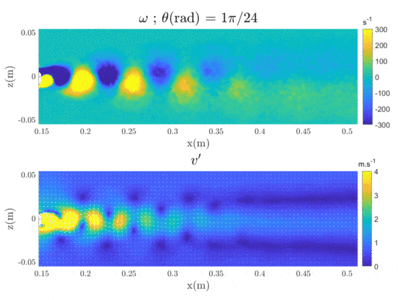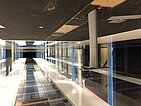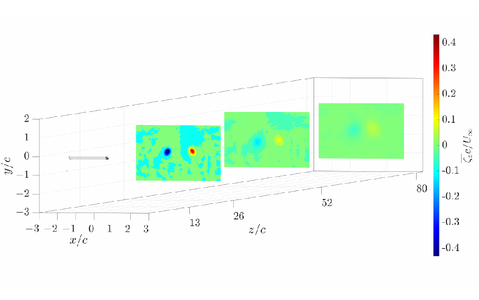Research
The research conducted using the ressources of PLEX platform is mainly based on :
- Turbulence in fluids (liquids and gases)
- Active and passive flow control
- Metrology for turbulent flows
Topic: Turbulence
EXPLOIT - Experimental Study of Dissipation Structures in Turbulence
This project is joint with CEA Saclay. Recent advances in the mathematical analysis of the equations governing viscous flows suggest that there is a link between the scaling of dissipation in a turbulent fluid and the development of singularities. However, very little is known about the dynamics and statistics of the corresponding dissipative structures. The EXPLOIT project aims to provide a characterization of dissipative structures based on experimental analysis of a turbulent flow model using multi-scale tools and advanced visualization techniques (4D PTV) in a dedicated metric-sized turbulent experiment. Highly resolved numerical simulations are also used to complete the approach and validate the analysis tools.
Experiment in the Grand Von Karman (GVK) at CEA Saclay
The turbulence generator is a cylinder of 1m diameter and 1m height with a rotor at the bottom of the tank and another rotor at the top. This device is known as the Von Karman tank. The two rotors can turn in the same direction (contra) or in opposite directions (anti). The Reynolds numbers reached in the experiment performed with water is ranging from 157,000 to 4,000,000.
- 4D PTV experiment, 4 cameras + laser at 1 kHz
- Measurement volume of 40 x 40 x 6 mm
- 1 pixel = 30 µm
- Kolmogorov length scale = 4 pixels for the experiment at lower Reynolds
Analysis of inter-scale and inter-space transfer in a non-homogeneous rotating flow
This study aims to explore and document the rotational turbulence generated in a mixer. It aims to understand how the turbulence properties are affected by the rotational motion in the tank and what are the underlying phenomena. For this purpose, different mixing configurations have been studied by modifying :
- The rotor speed: this has the effect of modifying the Reynolds number
- the geometry of the blades: this has the effect of modifying the turbulence initial conditions
- the topology of the flow, by adding anti-rotation blades (baffles)
2D2C high speed PIV measurement in water
- 30 x 30 mm area of interest located under the rotor
- High magnification, 1 pixel = 14 µm
- Acquisition of 50 000 packets of 3 successive maps (1 kHz) for a very good statistical convergence
How turbulence is impacted by its inhomogeneity in space
With baffles, turbulence is spatially inhomogeneous. Surprisingly, some results of the classical theory of isotropic homogeneous turbulence remain applicable. From this study it seems that a balance between the energy created by the pressure and the transport of turbulent energy in space allows to explain these results. On the other hand, in the case without anti-rotation vanes, the fluid follows a motion comparable to a solid rotational motion and the turbulence generated does not follow the classical theory. This has an impact on the way the turbulence is generated within the mixer by generating constraints that change these properties drastically.
DYNEOL - Turbulence DYNamics around wind and marine turbine blades
The DYNEOL project proposed by the CORIA, LEGI, LMFL and PPRIME laboratories, is a fundamental research project which aims to quantifying the dynamics of the flow around a blade as a function of the upstream flow. The latter can be composed of different families of coherent structures or have a mean shear due to a large boundary layer. The blade itself can be fixed or rotating. These situations are encountered on wind/hydro turbines and are not taken into account in global performance models. To study the interactions of the upstream turbulence with the blade, an original approach is followed: optical diagnostics and high fidelity simulations will be implemented to analyze the conditioned kinetic energy budget. This innovative analysis will be completed by proven analysis methods such as the "Proper Orthogonal Decomposition" or the "Dynamic Mode Decomposition" but which will be applied for the first time to this type of flow. Fixed and moving wing configurations will be studied. The 2D and 3D PIV will be compared to large-scale simulations to evaluate the quality of the different approaches and to understand their interactions.
Case of the interaction between the wake of one or more blade elements in a turbulent boundary layer
The interaction of the wakes of several elements mounted one behind the other in the turbulent boundary layer is studied. For this purpose, several configurations have been studied. Objects such as cylinders and wings in the boundary layer at several heights, as well as cases of interactions between two cylinders or a cylinder and a wing have been tested. For the study of the wake, the 2D2C low speed PIV has been chosen. Each instantaneous field being decorrelated from each other, an original method has been developed to perform a phase reconstruction.
Large scale PIV experiment behind the objects
- 590 x 150 mm field
- 4 cameras to follow the wake evolution in the boundary layer far from the objects
Topic: Flows control
Wingtips vortices control
This thesis conducted at the University of Naples Federico II, was focused on the experimental study of the effectiveness of synthetic jet control on wingtip vortices and their wake, generated by a low aspect ratio rectangular wing, in order to preserve the mutual induction of counter-rotating vortices during their evolution. Active control was designed to trigger the inherent Crow and Widnall instabilities at different momentum coefficients Cμ with the aim of reducing the strength of the vortices, on one hand, by reducing their circumferential velocities, and on the other hand, by improving the dissipation of the vortices through their early binding in the wake. Stereoscopic particle image velocimetry has been widely used as a measurement technique for the evaluation of the three velocity components. In particular, it has been used in the large boundary layer wind tunnel to evaluate the efficiency of the far-field wake.

![[Translate to English:] Organisme financeur [Translate to English:] Accès à l'organisme financeur : l'Europe s'engage en Hauts-de-France](/fileadmin/user_upload/plateforme-experimentale-turbulence/images/logos/europe_HDF.svg)
![[Translate to English:] Organisme financeur [Translate to English:] Accès à l'organisme financeur : Région Hauts-de-France](/fileadmin/user_upload/plateforme-experimentale-turbulence/images/logos/Logo_Re__gion_HDF.svg)
![[Translate to English:] Organisme de tutelle : CNRS [Translate to English:] Accès à l'organisme de tutelle : CNRS](/fileadmin/user_upload/plateforme-experimentale-turbulence/images/logos/logo_CNRS.svg)
![[Translate to English:] Organisme de tutelle : Centrale Lille [Translate to English:] Accès à l'organisme de tutelle : Centrale Lille](/fileadmin/_processed_/3/3/csm_logo_centrale_lille_cf284674ba.png)
![[Translate to English:] Organisme de tutelle : Université de Lille [Translate to English:] Accès à l'organisme de tutelle : Université de Lille](/fileadmin/_processed_/3/c/csm_ULille_logo_2fae4f0874.png)
